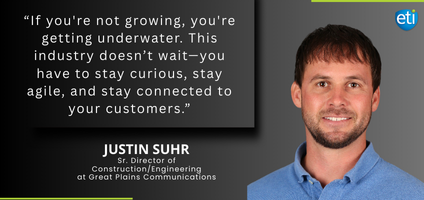
The following summary has been condensed for length and readability. To listen to the full discussion, click here. This episode is sponsored by ETI Software and VETRO FiberMap.
In this episode of the Broadband Bunch recorded at Fiber Connect 2025 in Nashville, Tennessee, host Brad Hine talks with Justin Suhr, Senior Director of Construction Engineering at Great Plains Communications. With over 25 years in the telecommunications industry, Justin brings expertise in outside plant engineering, fiber deployments, and navigating the evolving landscape of broadband expansion.
Great Plains Communications (GPC) has a storied history dating back 115 years as a traditional ILEC. But as Justin shares, the company has transformed into a future-ready fiber powerhouse. Operating across 13 states with over 19,000 fiber route miles, GPC has fully embraced modern telecommunications—supporting everything from residential FTTH builds to hyperscaler interconnects and enterprise services.
Their growth strategy hinges on adaptability—whether through M&A activity or new market penetration. As Justin puts it, “If you’re not growing, you’re getting underwater.”
Originally scheduled to speak on BEAD deployments at the show, Justin’s panel shifted focus due to delays in BEAD funding. Instead, the conversation turned toward how operators like GPC are planning around uncertainty—balancing investments in residential builds, middle-mile connectivity, hyperscaler needs, and tower-to-tower backhaul.
Rather than wait, GPC is pushing forward with contingency planning and capital deployment, ensuring underserved communities still get connected.
Justin highlights how AI is becoming an internal and external game-changer for operators. Internally, GPC is exploring AI for customer service analysis and call readouts. Externally, the focus is on building fiber infrastructure for AI-intensive clients, including hyperscalers needing high-count, high-capacity fiber networks between data centers.
But deploying AI effectively depends on clean data and system interoperability—a point that resonated deeply with the Fiber Connect audience. GPC’s investment in VETRO FiberMap as its single source of truth enables seamless integration across engineering, finance, inventory, and operations. Justin emphasizes the critical need to eliminate “swivel-chair” workflows through API-based software integration.
“You can’t be siloed anymore. Full APIs between systems are non-negotiable.”
Justin recounts the challenges GPC faced during the pandemic—from strained supply chains to shifting customer install protocols. These hurdles, however, drove efficiency gains, like self-scheduling installs and rapid software adoption.
The pandemic also spotlighted the urgency of rural broadband access. GPC deployed new services to support remote learning and work, emphasizing their commitment to community-first connectivity.
GPC maintains a close partnership between its regulatory and construction teams to capitalize on funding opportunities. From EACM to reverse auctions and broadband bridge grants, GPC works to ensure that every funding source is matched with a viable deployment strategy—helping expand their reach beyond traditional markets.
Training and upskilling are key themes in the episode. Justin explains how digital transformation is about more than adopting new tools—it’s about creating internal pathways that allow engineering, finance, and IT to operate from shared platforms and processes.
He also touches on emerging technologies like VR, noting their potential role in underground mapping and workforce collaboration.
While GPC has adopted tech-forward practices, Justin still firmly sees the company as a communications provider, not a tech company. Their north star remains the customer, whether that’s a rural household or a data center requiring petabyte-scale transport.
Their goal? Keep pushing the industry forward—deploying broadband wherever it’s needed most, powered by strategy, innovation, and a relentless focus on execution.
© 2025 Enhanced Telecommunications.